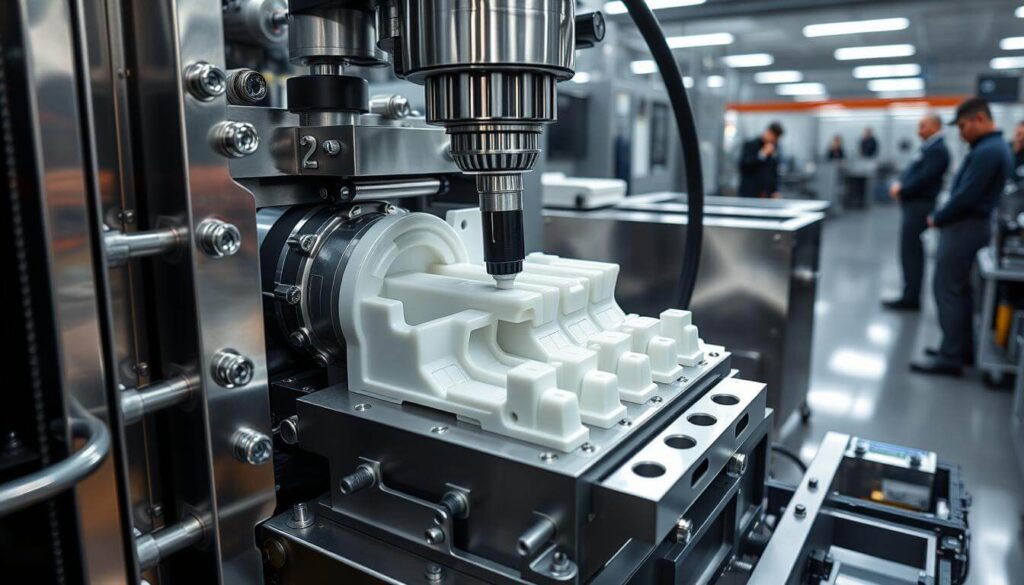
The injection molding process is complex and creates plastic products. Dark spots are a common issue that affects these products’ quality. They can appear for many reasons, impacting the product’s look and quality.
Dark spots in injection molding can lead to product rejection and financial losses. It’s key to find out why these spots happen and take steps to stop them. By improving the molding process and using quality control, manufacturers can make better products.
Key Takeaways
- Dark spots can affect the quality and appearance of injection molded products
- Understanding the causes of dark spots is crucial to implementing effective solutions
- Optimizing the injection molding process can help minimize the occurrence of dark spots
- Quality control measures are essential to preventing dark spots in plastic injection molding
- Effective solutions can be implemented to eliminate dark spots and ensure consistent quality
- Manufacturers can produce high-quality products by addressing the issue of dark spots
Understanding Dark Spots in Injection Molded Products
Dark spots on injection molded products can really affect how they look and work. It’s key to know what causes these spots. Thermal degradation and contamination are big reasons for dark spots. Spotting these issues helps find ways to fix them.
To get rid of dark spots, you need to know why they happen. Quality control measures are vital to stop dark spots before they start. This means checking the making process and testing materials and finished products often.
- Thermal degradation spots, caused by too much heat during making
- Contamination spots, caused by foreign stuff in the materials or making area
Knowing why dark spots appear helps makers stop them. This way, they can make sure their products are top-notch and consistent.
Primary Causes of Dark Spots During Manufacturing
The process of making injection molded products is complex. Several factors can lead to dark spots. It’s important to know these causes to avoid injection molding defects and keep product quality high. Common reasons for dark spots include not drying the material enough, setting the temperature wrong, and not purifying the material well.
Material choice, machine settings, and how it’s processed all affect the final product. For example, if the material isn’t dried right, dark spots can form. Wrong temperature settings can also cause the material to break down, leading to dark spots. Not purifying the material enough can introduce impurities, causing dark spots too.
To stop dark spots, manufacturers need to control the manufacturing process well. They must check the temperature, humidity, and material quality to avoid injection molding defects. By taking steps to prevent dark spots, manufacturers can keep product quality steady and lower the chance of injection molding defects.
Some important things to think about when stopping dark spots include:
- Material selection and quality control
- Machine settings and parameter optimization
- Processing conditions, such as temperature and humidity
- Material purification and drying
By managing these factors well, manufacturers can reduce dark spots and keep product quality consistent.
Material Degradation and Its Effects
Material degradation is a big problem in making injection molded products. It happens when the material’s properties change, making it less good. Knowing why this happens helps us avoid dark spots and make better products.
When material degradation happens, the thermal stability goes down. This is because high temperatures can break down the material’s molecules. Dark spots can form because of this. Also, material degradation can make the material brittle and prone to cracking if it has too much moisture.
Some things that can cause material degradation include:
- Temperature-related issues, such as excessive heat or cold
- Moisture content problems, such as high humidity or exposure to water
- Chemical breakdown factors, such as exposure to harsh chemicals or cleaning agents
To stop material degradation and dark spots, we need to pick materials that can handle heat well. We also need to check the material’s properties and watch the production process closely. This way, we can make sure the final product is up to standard.
Machine Settings and Parameter Optimization
Optimizing machine settings is key to avoiding dark spots in injection molded products. Understanding how machine settings affect product quality is vital. Temperature, pressure, and flow rate are critical factors to consider.
Getting machine settings right involves a deep look at the production process. It’s important to think about the material, mold design, and the quality needed. Adjusting these factors can lower the chance of dark spots and keep product quality high.
Some important things to think about include:
- How temperature affects material properties
- The impact of pressure on filling the mold and product quality
- Optimizing flow rate to avoid material damage
By using these strategies, manufacturers can make their products better and reduce dark spots. Keeping an eye on and tweaking machine settings and parameters is key to good production.
With careful machine settings and parameter optimization, manufacturers can make sure their products are top-notch. This boosts their reputation and makes customers happier.
Quality Control Methods for Injection Molded Products
Effective quality control methods are key to spotting and stopping dark spots in injection molded products. To keep product quality high, makers use various methods. These include checking products and testing them. This way, they lower the chance of dark spots and keep customers happy.
Quality control mixes visual checks and advanced tests. Visual checks help spot surface defects like dark spots. Advanced tests find hidden issues and check the product’s physical and chemical makeup.
Key Quality Control Steps
- Visual inspection of products for visible defects
- Advanced testing methods, such as spectroscopy and chromatography
- Documentation and tracking of test results and product data
By using these quality control steps, makers can make sure their products are up to standard. This builds trust with customers, leading to more business and success.
Preventive Maintenance Strategies
Using preventive maintenance is key to lessening dark spots in injection molded products. Regular upkeep cuts down on equipment failure, material damage, and human mistakes. This leads to better product quality and saves money on fixes or rework.
Preventive maintenance includes equipment checks to spot problems early. This way, manufacturers can fix small issues fast, cutting down on lost time and boosting output. These checks also help find ways to improve preventive maintenance, making maintenance plans and actions better.
- Regularly scheduled equipment checks to identify potential issues
- Implementation of preventive maintenance schedules to minimize downtime
- Training operators to recognize and address potential issues promptly
By adding these strategies to their upkeep, makers can lower the chance of dark spots and keep product quality steady.
Troubleshooting Common Dark Spot Issues
When dealing with dark spots in injection molded products, troubleshooting is key. It helps find and fix the main problems. By knowing what causes dark spots, makers can solve issues fast. This cuts down on lost time and boosts product quality.
Dark spots can come from material wear, wrong machine settings, or bad environment. To fix these, makers should follow a few steps:
- Check the material for damage or dirt
- Make sure machine settings are right
- Look at the environment, like temperature and humidity
By using a methodical approach to troubleshooting, makers can find and fix dark spot problems. This makes products better and saves money. It also makes work more efficient.
Regular troubleshooting and upkeep can stop dark spots before they start. Keeping an eye on problems and fixing them quickly means products are always top-notch.
Conclusion: Ensuring Consistent Quality in Injection Molding
To get consistent quality in injection molding, you need a few key steps. First, understand why dark spots happen. Then, use quality control steps and adjust machine settings to fix the problem. This guide offers tips and strategies to tackle dark spots and improve your manufacturing process.
Keeping your equipment in top shape, handling materials right, and training your team well are crucial. Also, using advanced tests and keeping detailed records helps a lot. By following these steps, you can lower the chance of dark spots and make sure your parts are top-notch.
The secret to consistent quality in injection molding is being proactive and using data. By following the advice in this guide, you can make your production better, cut down on mistakes, and give your customers the best products.
FAQ
Dark spots can greatly affect the look and function of molded products. They can lead to poor appearance, reduced strength, and even product failure.
Dark spots in injection molding are mainly caused by a few key factors. These include not drying materials enough, setting temperatures incorrectly, not purifying materials well, and material degradation.
Adjusting machine settings like temperature, pressure, and flow rate is key. It helps ensure products are made consistently and prevents dark spots.
To spot and stop dark spots, quality control uses several methods. These include visual checks, advanced tests, and tracking procedures. They help find and fix the dark spot causes.
Preventive maintenance is vital in avoiding dark spots. It includes regular equipment checks, proper material storage, and training for operators. These steps help prevent equipment failure, material damage, and operator mistakes.


The injection molding process is complex and creates plastic products. Dark spots are a common issue that affects these products